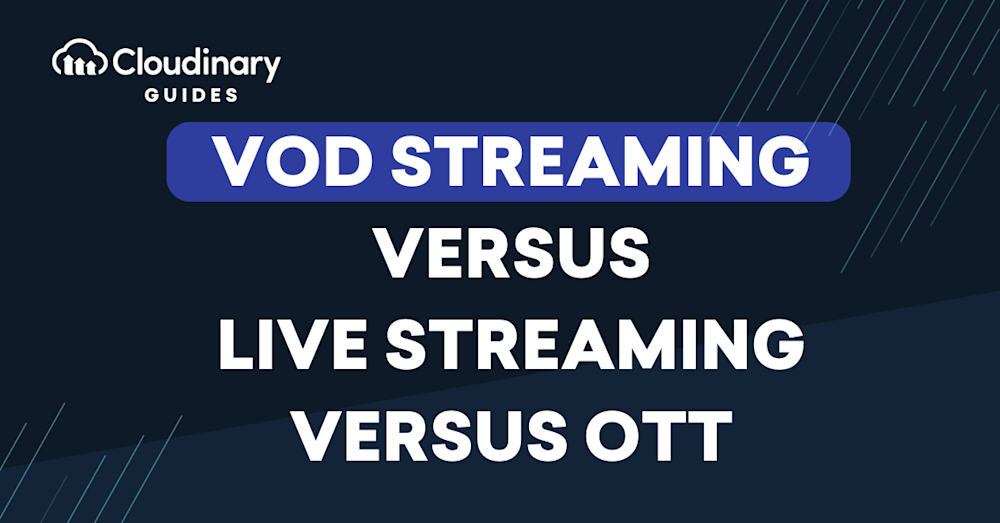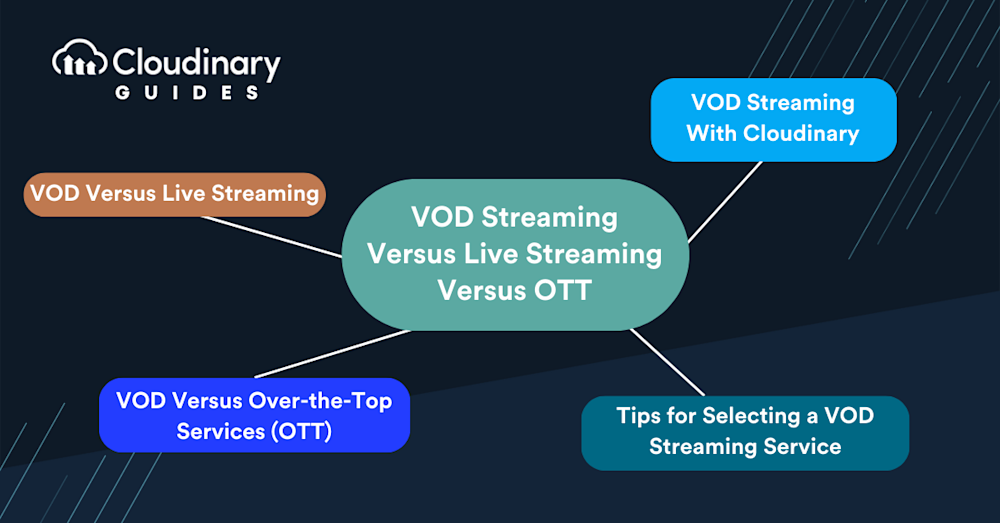What Is VOD Streaming?
Video on demand (VOD) streaming is a digital media distribution system that empowers viewers to access and watch video content whenever they choose, rather than being tied to a scheduled broadcast. By leveraging internet-connected devices such as TVs, computers, tablets, and smartphones, VOD platforms store video files on servers, enabling users to stream or download content at their convenience. This flexibility and accessibility have made VOD a cornerstone of modern media consumption, with popular platforms like Netflix, Amazon Prime Video, and Hulu exemplifying its widespread adoption.
VOD stands out for its user-centric approach, offering unparalleled control over what, when, and how viewers watch video content. Whether streaming in real time or downloading for later viewing, users benefit from the convenience of on-demand access, eliminating the constraints of traditional broadcast schedules. As a result, VOD has transformed not only entertainment but also industries like healthcare and education, providing a flexible, accessible, and engaging way to consume video content across a multitude of devices and use cases.
VOD isn’t just reshaping entertainment—it’s transforming industries across the board. In healthcare, medical trainees are turning to on-demand surgery videos to enhance their learning and refine techniques. Similarly, businesses are using VOD to host employee training sessions and customer education programs, making professional development more accessible and flexible than ever.
This article covers these topics:
- VOD Versus Live Streaming
- VOD Versus Over-the-Top Services (OTT)
- Key Aspects of Video on Demand (VOD)
- Tips for Selecting a VOD Streaming Service
- VOD Streaming and OTT Monetization Models
- VOD Streaming With Cloudinary
VOD Versus Live Streaming
A live stream is recorded video that is transmitted in real time via the internet. Since the content is not on demand at the time of recording, the stream is recorded and transmitted simultaneously.
The distinction in editing and production flexibility is notable here. VOD offers more latitude, allowing for post-production enhancements. Conversely, live streaming demands a more complex technical setup, and once the content is live-streamed, there’s nearly no opportunity for editing.
Once the stream is complete, you can upload it to a site such as YouTube or Twitch, which viewers can access as a video-on-demand. Remember that not all VODs started as live-streamed videos and that not all streams will become VODs. Despite the overlap between VOD and live streaming, they remain distinct processes.
Take Twitch, for example—on this platform, VODs serve as replays of live streams, giving audiences a chance to catch up on content they missed. But they’re more than just reruns. These on-demand videos are essential tools for creators looking to grow their communities, offering continuous engagement and discoverability long after the live stream ends.
Video on demand (VOD) refers to content that’s prerecorded and available for viewers to watch whenever they choose. Unlike live streams, VOD gives users complete control—they can pause, rewind, or rewatch at their own pace. Platforms like Twitch use VOD to store past broadcasts, helping creators grow their audience by making content accessible even after the live event ends. It’s a flexible, viewer-friendly format that enhances engagement and retention.
VOD is convenient since it can be accessed any time, so are streams due to the potential for live interactions.
Live streaming itself increasingly happens over OTT infrastructures. vMVPD offerings (YouTube TV, Hulu + Live TV, Sling TV) deliver real-time channels via the internet, then archive many programs as VOD for later viewing. This blurs the line: a single piece of content may debut live, then persist as VOD on the same OTT platform.
Related content: Preparing Live Streams for VOD
VOD Versus Over-the-Top Services (OTT)
OTT refers to platforms and technology that permit video streaming via the internet with direct delivery of video content to viewers, bypassing traditional media channels like cable TV and broadcasting stations.
Besides video streaming; OTT also works for VoIP and audio calls. All OTT needs is a reliable Internet connection.
OTT is a valuable model of content delivery for general business purposes and entertainment providers. Because its video delivery costs less than traditional broadcasting, OTT has become popular among companies and viewers alike.
OTT offers the following benefits:
- Customer-centric, multitiered pricing plans
- The ability to view videos anywhere, any time
- Smooth user experience over devices
- Real-time customer data and audience metrics
- Minimal disturbances in content delivery
- Improved content segmentation
A common question that comes up is: what’s the difference between OTT and VOD? While they’re closely related, they’re not the same. VOD (Video on Demand) refers to any video content viewers can watch at their convenience, while OTT (Over-the-Top) is the method of delivering that content over the internet without traditional cable or satellite. In short, OTT is the delivery platform, and VOD is one type of content it can deliver.
- OTT determines how the content is delivered to viewers by providing the technology behind the actual distribution.
- VOD is a way of describing how viewers consume content.
Thus, VOD is a consumption framework; OTT, a distribution framework. Viewers can watch both live streams and VOD on OTT platforms.
Key Aspects of Video on Demand(VOD)
- Accessibility: VOD content can be accessed on a wide range of devices, including TVs, computers, tablets, and smartphones, making it easy for users to watch videos wherever they are.
- Flexibility: Viewers have the freedom to choose what they want to watch, when they want to watch it, and how they want to watch it—either by streaming instantly or downloading for offline viewing.
- Convenience: VOD eliminates the need to adhere to a specific broadcast schedule, allowing users to pause, rewind, or rewatch content at their own pace.In essence, VOD provides a user-friendly and highly customizable way to consume video content, offering viewers greater control and a more engaging experience compared to traditional broadcast methods.
Tips for Selecting a VOD Streaming Service
Most consumer-focused social media and video-hosting platforms simply don’t offer the features and scalability that organizations and high-volume broadcasters need. To deliver a fully professional and seamless content experience, broadcasters are better off choosing enterprise-grade platforms. Here’s why:
- White label streaming — Use your colors, images, and logos to make your brand stand out from the competition. Content is shown ad free with no interruptions.
- API and SDK access — Integrate your current workflows or develop your own OTT platform and mobile application from the very beginning.
- Multi User access — Offer user permissions and custom access controls within your organization and for all audiences. Leverage built-in safety features to ensure that only your intended audience can see or share the content.
- Recording of live streams — If you’re streaming live content and wish to make it available as VOD later, you can convert the live stream by opening the “Live-to-VOD” tab on your stream dashboard, entering the stream name, clicking “Create Pre-recorded Stream”, and then finishing the setup for the Pre-recorded stream.
- Recording of live streams — Capture events as they take place and automatically store them in your VOD library. Organize your CMS with filters and tags to improve functionality and search options.
- Scalable content delivery — Offer an optimized experience through content delivery networks (CDN) and enable viewing on a wide range of devices.
When vetting platforms, also consider whether they:
- Support both SVOD and AVOD (or hybrid) business models, and potentially TVOD/pay-per-view for premium drops.
- Provide toolsets for live-to-VOD workflows on OTT channels (crucial for vMVPD-like offerings).
- Offer robust device SDKs (smart TV, Roku/Fire TV, iOS/Android, game consoles) to guarantee consistent playback across the full device taxonomy.
- Enable audio-only OTT pipelines if your catalog includes podcasts or music.
VOD Streaming and OTT Monetization Models
Video on Demand (VOD) streaming has emerged as a dominant force, revolutionizing how audiences access and engage with content. Various monetization models have evolved, with Over-the-Top (OTT) monetization stranding out as the most popular implementation.
1. Advertising Video on Demand
Advertising Video on Demand (AVOD) operates on the principle of providing content to viewers for free, with revenue generated through advertising. Platforms such as YouTube and Vimeo follow this model, offering a vast array of content at no direct cost to the viewer. Instead, advertisements are strategically integrated into the viewing experience, generating revenue for the platform.
For content creators, AVOD presents an opportunity to reach a broad audience without imposing direct fees on viewers. However, success in this model often hinges on factors such as ad engagement, viewer retention, and the platform’s ability to effectively monetize content through targeted advertising.
A major hurdle with AVOD is finding the sweet spot between ad volume and user satisfaction. Bombarding viewers with too many ads can drive them away, reducing engagement and hurting revenue. That’s why successful platforms lean on smart algorithms and detailed user analytics to fine-tune ad delivery—ensuring it feels natural, not intrusive, while still supporting monetization goals.
2. Subscription Video on Demand (SVOD)
SVOD, short for Subscription Video on Demand, is the go-to model for services like Netflix, Disney+, and Amazon Prime Video. It works on a recurring payment basis, giving subscribers unlimited access to a vast content library. One of its biggest perks? A seamless viewing experience—no ads, just uninterrupted binge sessions at your own pace.
From a business standpoint, SVOD offers a predictable revenue stream, enabling platforms to invest in high-quality original content and enhance user experience. Moreover, the absence of ads eliminates potential friction points for viewers, fostering a seamless and immersive viewing environment.
The success of SVOD platforms doesn’t just rely on having content—it depends on the right content, smart pricing, and keeping viewers coming back. In a crowded market full of streaming options, platforms need to stand out through diverse libraries, competitive subscriptions, and fresh, engaging offerings that keep users hooked month after month.
3. Transactional Video on Demand
Transactional Video on Demand (TVOD) represents a pay-per-view model, wherein viewers pay a fee to access specific content on-demand. Platforms like iTunes, Google Play Movies, and Vudu exemplify this model, offering a vast catalog of movies and TV shows available for individual purchase or rental.
For consumers, TVOD offers the advantage of on-demand access to premium content without the need for a subscription. This model is perfect for occasional viewers or those looking for specific titles, allowing them to pay only for what they want to watch, when they want to watch it.
For content creators and distributors, TVOD presents an additional revenue stream, particularly for new releases or niche content that may not fit within the subscription model. However, success in TVOD often relies on effective marketing and pricing strategies to entice viewers to make individual purchases or rentals.
These monetization levers apply equally to OTT at large, not just video VOD. For example, Spotify uses a freemium AVOD/SVOD hybrid (ads on free tier, subscription for ad-free listening), while some podcast platforms experiment with episode-level TVOD. Meanwhile, vMVPDs typically bundle channels under an SVOD-like monthly fee, sometimes layering AVOD for lower-priced tiers.
Pro TipExtend your Reach with Cloudinary’s Video Player
Thinking of reaching a broader audience with your Video on Demand (VOD) content? Cloudinary’s Video Player is designed to seamlessly integrate with your backend scheduling, bringing your content to a wider range of devices and platforms.
VOD Streaming With Cloudinary
VOD, also known as simulated live streaming, allows you to stream a prerecorded video or event at a scheduled time, giving it the feel of being live. This is especially useful for webinars or seminars that need to be prerecorded. To implement this with Cloudinary, you can choose from the following methods, depending on your specific use case and infrastructure:
- Use RTMP live streaming
- Extend the Cloudinary Video Player’s functionality and combine it with back-end scheduling
With Cloudinary’s robust and masterful APIs, you can more efficiently and effectively manage and redistribute content, automating what many people assume must be done manually. Do try out the features by first signing up for a free account.
In the world of devices for accessing VOD, there’s a broad selection available. From Smart TVs and Roku devices to gaming consoles like Xbox, the options are vast. Furthermore, when considering online streaming services, platforms like Hulu and Netflix stand out as popular choices for viewers seeking VOD content.


